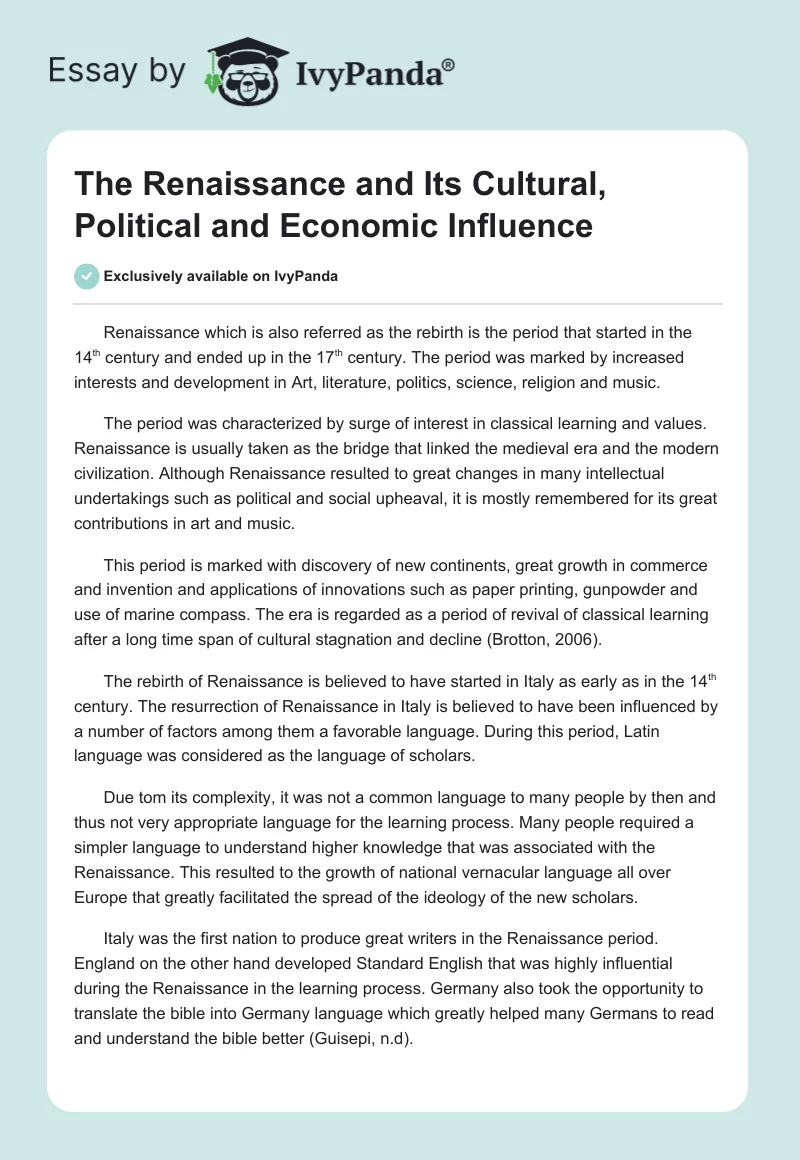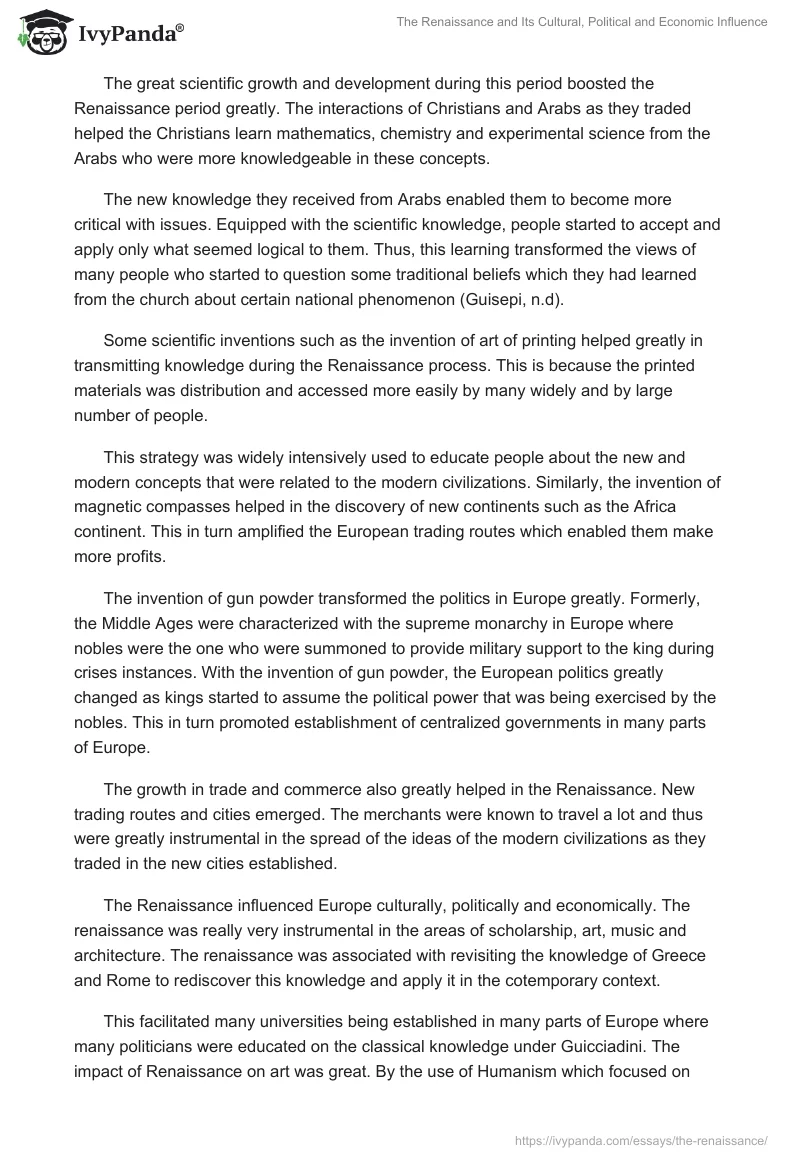Renaissance which is also referred as the rebirth is the period that started in the 14th century and ended up in the 17th century. The period was marked by increased interests and development in Art, literature, politics, science, religion and music.
The period was characterized by surge of interest in classical learning and values. Renaissance is usually taken as the bridge that linked the medieval era and the modern civilization. Although Renaissance resulted to great changes in many intellectual undertakings such as political and social upheaval, it is mostly remembered for its great contributions in art and music.
This period is marked with discovery of new continents, great growth in commerce and invention and applications of innovations such as paper printing, gunpowder and use of marine compass. The era is regarded as a period of revival of classical learning after a long time span of cultural stagnation and decline (Brotton, 2006).
The rebirth of Renaissance is believed to have started in Italy as early as in the 14th century. The resurrection of Renaissance in Italy is believed to have been influenced by a number of factors among them a favorable language. During this period, Latin language was considered as the language of scholars.
Due tom its complexity, it was not a common language to many people by then and thus not very appropriate language for the learning process. Many people required a simpler language to understand higher knowledge that was associated with the Renaissance. This resulted to the growth of national vernacular language all over Europe that greatly facilitated the spread of the ideology of the new scholars.
Italy was the first nation to produce great writers in the Renaissance period. England on the other hand developed Standard English that was highly influential during the Renaissance in the learning process. Germany also took the opportunity to translate the bible into Germany language which greatly helped many Germans to read and understand the bible better (Guisepi, n.d).
The great scientific growth and development during this period boosted the Renaissance period greatly. The interactions of Christians and Arabs as they traded helped the Christians learn mathematics, chemistry and experimental science from the Arabs who were more knowledgeable in these concepts.
The new knowledge they received from Arabs enabled them to become more critical with issues. Equipped with the scientific knowledge, people started to accept and apply only what seemed logical to them. Thus, this learning transformed the views of many people who started to question some traditional beliefs which they had learned from the church about certain national phenomenon (Guisepi, n.d).
Some scientific inventions such as the invention of art of printing helped greatly in transmitting knowledge during the Renaissance process. This is because the printed materials was distribution and accessed more easily by many widely and by large number of people.
This strategy was widely intensively used to educate people about the new and modern concepts that were related to the modern civilizations. Similarly, the invention of magnetic compasses helped in the discovery of new continents such as the Africa continent. This in turn amplified the European trading routes which enabled them make more profits.
The invention of gun powder transformed the politics in Europe greatly. Formerly, the Middle Ages were characterized with the supreme monarchy in Europe where nobles were the one who were summoned to provide military support to the king during crises instances. With the invention of gun powder, the European politics greatly changed as kings started to assume the political power that was being exercised by the nobles. This in turn promoted establishment of centralized governments in many parts of Europe.
The growth in trade and commerce also greatly helped in the Renaissance. New trading routes and cities emerged. The merchants were known to travel a lot and thus were greatly instrumental in the spread of the ideas of the modern civilizations as they traded in the new cities established.
The Renaissance influenced Europe culturally, politically and economically. The renaissance was really very instrumental in the areas of scholarship, art, music and architecture. The renaissance was associated with revisiting the knowledge of Greece and Rome to rediscover this knowledge and apply it in the cotemporary context.
This facilitated many universities being established in many parts of Europe where many politicians were educated on the classical knowledge under Guicciadini. The impact of Renaissance on art was great. By the use of Humanism which focused on humanity, the modern concepts that were learned enabled the artist to break from art- dictated art of the Middle Ages and embrace the secular worldview.
In addition, architecture developed greatly which enabled the traditional architecture of the middle ages being replaced by more modern human-centric architecture that was highly embraced all over Europe. Similarly, the Renaissance resulted to enhanced growth and development in trade and commerce that resulted to emergence of banking facilities in many parts of Europe.
Enhance trade in turn resulted to emergence of urban centers and cities such as Florence and Venice cities that eventually transcended to become empires.
Other European nations such as England and Spain followed suite to establish their own cities. The establishment of cities resulted to a great change in European politics which necessitated the idea of diplomacy. Many people in Europe and especially Italy studied diplomacy during the Renaissance period.
It was from Italy that the concept of permanent, resident ambassadors originated during the Renaissance period. The concept of diplomacy enables Italy to maintain very important international relations up to date (Craig, Graham, Kagan, Ozment, & Turner, 2009).
The Protestant Reformation was a European Christian reform movement that resulted to the establishment of Protestantism as a constituent part of the contemporarily Christianity. The movement was initiated as a protest towards certain catholic rituals, doctrines and ecclesiastical structures of the Catholic Church.
The protest resulted to a Counter Reformation movement which was headed by Jesuit order. The Counter Reformation resulted to reclamation of many parts of Europe which include Poland, parts of England back to Catholic faith.
The reason that motivated the reformation to initiate in Germany is because Germany was the first nation that translated the bible into Germany language which enhanced the Germans to understand the bible when they read it more effectively. Well understanding of the bible prompted Germans Christians to start questioning some Catholic rituals and doctrines which they considered to contradict the Christianity teaching as expressed by the bible.
The scientific discoveries that accompanied the Renaissance enlightened people greatly. One of great discovery is the Copernican theory which suggested that the sun and other planet rotated around a central sun. This discovery faced a lot of resistance from many scholars and also from the theologians who contested with this discovery as they claimed it contradicted what the bible stated.
This fact was proved later when Galileo invented telescope that was used to clearly view distant objects. The civilizations that was associated with Renaissance was enlightened people could not any longer take anything for granted, but did their best to look for relevant facts to support ideas (Cronin,1992) .
Reference List
Brotton, J. (2006) The Renaissance: A Very Short Introduction. New York: Prentice Hall.
Craig, A. M., Graham, W. A., Kagan, D., Ozment, S., & Turner, F. M. (2009). The heritage of world civilizations (8th ed.). Upper Saddle River, NJ: Pearson Prentice Hall.
Cronin, V. (1992). The Renaissance. London: Oxford University Press.
Guisepi, R.A. (n.d). The Renaissance Beginning and Progress of the Renaissance. Web.


